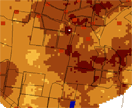Soil texture is the classification of soil that is based on the relative proportion of the various of ultimate soil particles (i.e. sand, silt and clay). The soil texture classes include: clay, sandy clay, silty clay, clay loam, silty clay loam, sandy clay loam, loam, silt loam, silt, sandy loam, loamy sand, and sand.
During morphological description of a soil profile in the field, one of the first properties determined is the soil texture of the various horizons. The reason for this is that soil texture does not change significantly and hence is a fundamental soil property. As such it gives a soil scientist an idea of the various soil factors and processes that have led to its formation.
From a practical stand point, soil texture determination is also one of the most important soil variables, because it has greatest impact on soil management with regard to determining;
- Land-use potential,
- Nutrient holding capacity,
- Ability to hold water for plant uptake,
- Ease of cultivation,
- Soil hydraulic properties,
- Estimate lime needed to raise soil pH, and
- In irrigated areas select suitable sites for farm dams, channels and drains.


